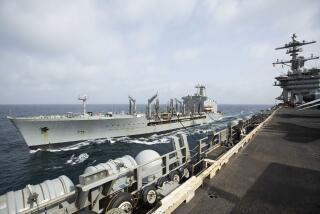Trump said Navy ships were headed toward North Korea. They were going the other way

Remember the U.S. Navy ships sent to scare North Korea? (April 19, 2017) (Sign up for our free video newsletter here http://bit.ly/2n6VKPR)
- Share via
Reporting from Washington — An aircraft carrier strike group that the Trump administration had warned was headed toward North Korea in a powerful show of force has instead spent the last week thousands of miles away — and heading in the opposite direction.
The Pentagon’s disclosure on April 8 that the Carl Vinson carrier strike force was being diverted to waters near North Korea had contributed to rising global tensions over a possible U.S. conflict with the nuclear-armed regime in Pyongyang.
Senior administration officials repeatedly cited the orders to rush the Carl Vinson strike force from Singapore to North Korea as a sign of President Trump’s willingness to directly confront a regime that has conducted five nuclear tests and multiple missile launches in violation of United Nations resolutions.
It was widely assumed that the carrier group was patrolling somewhere within range last weekend, when U.S. officials feared Kim Jong Un’s military would conduct a sixth underground nuclear test, or would try to test launch an intercontinental ballistic missile for the first time.
The U.S. ships have the ability to shoot down incoming missiles and launch cruise missiles of their own.
On Saturday, Pyongyang staged a massive parade that displayed new missiles and had warned that it would counter a U.S. attack with “a nuclear war of our own.” The next day, the regime attempted to test a mid-size ballistic missile, but it exploded seconds after launch in the sea off the east coast.
The Navy’s admission that the Carl Vinson and four other warships were, in fact, conducting exercises in the Indian Ocean last week and were still in Indonesian waters as of Saturday has raised fresh questions about the credibility of the White House, which has frequently come under attack for making false claims.
Officials said Tuesday that the false narrative about the Carl Vinson resulted from mistakes and miscommunication up the military chain of command to the White House, and was not part of a deliberate military attempt to psych out North Korea’s leaders and mislead the public.
The embarrassing saga began when Adm. Harry Harris, who heads U.S. Pacific Command, initially announced in a news release on April 8 that he had directed the Carl Vinson carrier strike group to “sail north” from Singapore, adding that the ships were being diverted from planned port visits to Australia.
The Trump administration cited the deployment of the naval strike force, which includes the carrier and four warships, as a clear warning to North Korea, which was said to be planning a nuclear test last weekend in conjunction with a national holiday.
“We are sending an armada, very powerful,” to the waters off the Korean peninsula, President Trump told Fox Business News on April 12.
A day earlier, Defense Secretary James N. Mattis told Pentagon reporters that the aircraft carrier was “on her way up there.”
Some news organizations cited the armada’s apparent race northward as a sign of a possible preemptive attack on North Korea, spurring global concerns of a possible war.
While the Pentagon sought to downplay those reports late last week, at no point did it or the White House suggest the Carl Vinson was not, in fact, nearing the Korean peninsula to give Trump a more robust military option should he decide he needs one.
Pundits cited the warships’ approach as evidence of Trump’s muscular style in the same week that he had ordered a cruise missile strike on Syria in response to a poison gas attack, and the Air Force had dropped the so-called Mother of All Bombs on an Islamic State stronghold in Afghanistan.
But on Saturday, a full week after the initial news release, the Navy posted a photograph showing the Carl Vinson traveling south through the Sunda Strait between the Indonesian islands of Sumatra and Java — about 3,500 miles southwest of the Korean peninsula.
As Defense News first reported Monday, the strike force has been taking part in exercises with Australian forces in the Indian Ocean over the last week.
It is now — really — steaming northward and is expected to arrive in the Sea of Japan next week, U.S. officials said.
Twitter: @wjhenn
ALSO:
Climate change is real: Just ask the Pentagon
Trump administration stops disclosing troop deployments in Iraq and Syria
U.S. launches dozens of missiles at Syria in response to chemical weapons attack
More to Read
Sign up for Essential California
The most important California stories and recommendations in your inbox every morning.
You may occasionally receive promotional content from the Los Angeles Times.











